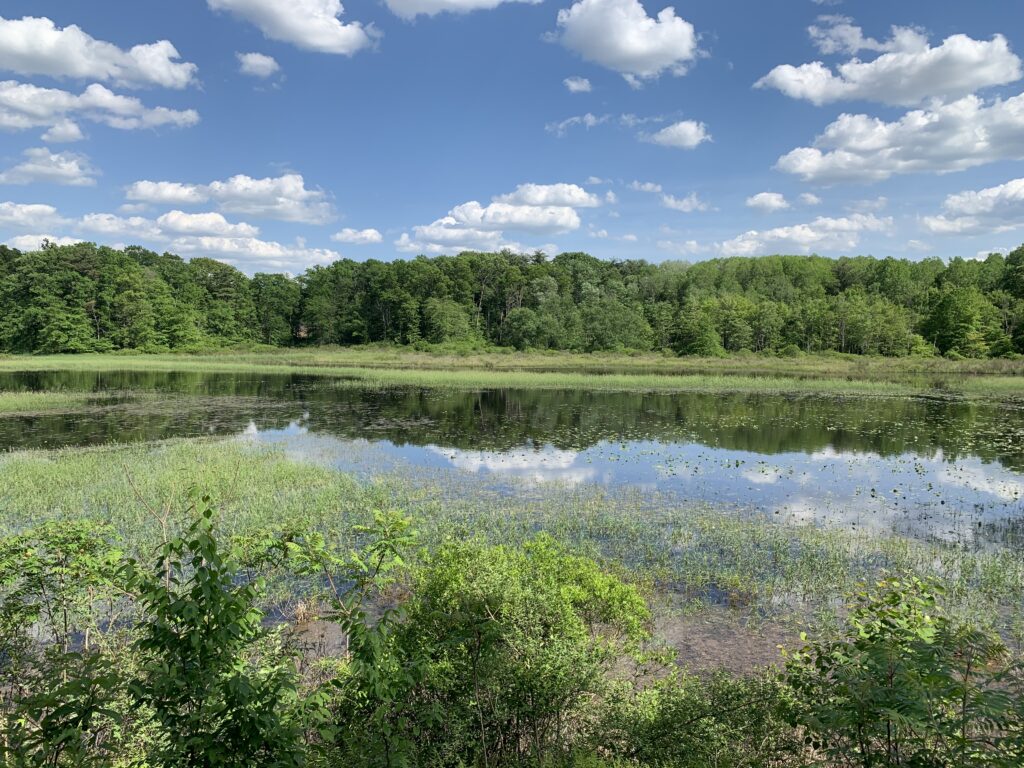The Scotia Barrens is a distinct ecozone of about 6,200 acres west of State College protected within State Game Lands #176. The area is a microclimate zone, with temperatures noticeably lower than the adjoining areas, that features plentiful plant and animal life. Scotia Barrens has been named a biological diversity area in the Centre County Natural Heritage Inventory.
“Barrens” ecosystems did not receive that name because they are devoid of life, but because they are dry and support distinct species that have adapted to the local conditions. The Scotia Barrens can be found in a low depression surrounded by ridgelines configured in such a way that cool and dry air accumulate in the depression.
The area has sandy and dry soil that deflects heat and retains that cool air and creates a feedback loop that makes the area several degrees colder than its surroundings. The meteorological process that makes Scotia Barrens cool is well understood, though the presence of sandy soil in this otherwise limestone-dominant geological region is something of a mystery.

Millennia of cool air and dry soil have created a pitch pine/scrub oak ecosystem that is uncommon in Pennsylvania. The pitch pine is short and stocky compared to related evergreens. The scrub oak, despite being a species of oak tree, keeps low to the ground and usually takes the shape of a round bush. This shrubbery-intensive ecosystem attracts certain animals and low-lying plants that prefer ground-level protection.
Scotia Barrens hosts robust populations of ruffed grouse (the Pennsylvania state bird) and American woodcock—both of which nest on the ground and prefer the protection of dense shrubs. The area is also of interest to birdwatchers thanks to a population of the rare golden-winged warbler. Other threatened species found in the area include the frosted elfin butterfly and a flowering sedge called the northeastern bullrush. The area also features several natural ponds and various low areas that become vernal pools in the spring and serve as breeding grounds for amphibians.
The Scotia Barrens area was once a bountiful source of iron ore, which was mined by Andrew Carnegie’s companies from the 1890s to 1910s, and briefly by the U.S. government during World War II. Carnegie built the town of Scotia for his workers, which grew to a population of about 400 before being abandoned. Some ruins of the ghost town can now be found within the boundaries of State Game Lands #176.
Barrens ecosystems are influenced by fire, as the dry conditions are conducive to wildfires set by lightning and sometimes by Indigenous populations. In particular, pitch pines are dependent on fire to open their tough cones for propagation. Such fires kept the ecosystem stable for millennia. In more modern times, fires set by careless industrial operations, such as hot coals flying off mining railroad engines, continued the process.
The 20th century practice of repressing natural forest fires and brush fires disrupted many barrens ecosystems across America, including the Scotia Barrens, and led to some loss of unique plant and animal life. In the 21st century, forestry practices have evolved to restore barrens to their natural state via more flexible fire management. One significant controlled-burn operation was conducted at Scotia Barrens in 2010.
Outside of hunting season, Scotia Barrens is a popular recreation area, particularly for birdwatchers and bikers. The area includes dozens of miles of trails, which are unofficial and unmarked. Some of the trails follow old road or railroad beds that have devolved into pleasant grassy lanes, but others were created haphazardly by walkers and bikers seeking ponds and ruins, or simply exploring quiet areas.
Scotia Barrens is most easily reached via the Grays Woods exit from Interstate 99 west of State College. Drive south on Grays Woods Boulevard, then turn left onto Scotia Road, and then turn left again onto Scotia Range Road. That road leads to several parking areas from which various trails depart.
Ben Cramer
Sources:
Bird Watchers Digest, “Scotia Gold: Searching for the Golden-winged Warbler,” https://bwdmagazine.com/explore/scotia-gold-searching-golden-winged-warbler/ (Accessed June 9, 2024).
Cramer, Ben (ed.). Pennsylvania Hiking Trails, 13th edition. Mechanicsburg, PA: Stackpole Books, 2014: pp. 77-79.
Clearwater Conservancy. “Scotia Barrens Conservation Project,” https://www.clearwaterconservancy.org/scotiabarrens (Accessed June 9, 2024).
Hughes, Mark. “A Geologic Wonder: Scotia Barrens,” Pennsylvania Center for the Book, https://pabook.libraries.psu.edu/literary-cultural-heritage-map-pa/feature-articles/geologic-wonder-scotia-barrens (Accessed June 9, 2024).
Pennsylvania Game Commission. “Barrens Habitat,” https://www.pgc.pa.gov/Wildlife/HabitatManagement/Documents/Barrens_Chapter.pdf (Accessed June 9, 2024).
Pennsylvania Natural Heritage Program. “Scotia Barrens,” https://www.naturalheritage.state.pa.us/cnhi/cnhi/Scotia%20Barrens.pdf (Accessed June 9, 2024).
First Published: June 30, 2024
Last Modified: February 24, 2025
